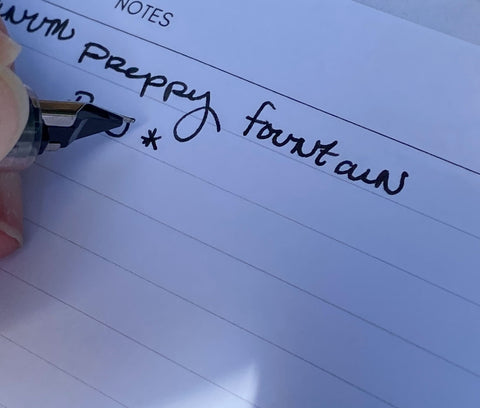C&P’s Beginner Guide to Fountain Pens
Fountain pens are unique writing utensils that are quite different from your everyday rollerball pen. I love using them for creative writing and doodling, as the writing experience is buttery smooth, allowing for precise handling. Since fountain pens function differently from rollerballs, getting started can be tricky. (I know that my first time learning how to use a fountain pen was daunting – I had no idea I had to “build” my pen!). That’s why we’ve compiled some helpful tips and tricks for using a fountain pen from Cloth & Paper below.

How to Use
Our Kokuyo x Platinum Preppy Perpanep Fountain Pen and Platinum Meteor Fountain Pen both use cartridges. Here are step-by-step instructions on assembling fountain pens with cartridges:
- Unscrew the cap and remove the barrel from the grip/nib section.
- Insert the ink cartridge in the pen's grip section until it punctures. If you can still hear the cartridge moving when you try to write, that means that it has not been installed correctly. Firmly press until you feel or hear the puncture.
- Reassemble the pen.
If you're having trouble with getting the ink to release, we recommend letting the ink saturate by pointing the pen downwards for a few minutes. You may also need to apply some pressure at an angle while writing to get the ink flowing. I use these fountain pens, and have found that resting the pen downwards in a pen holder or something similar helps with ink flow on first use.

Tips
Writing Using the “Sweet Spot”
Angle the pen at 45 degrees, then test your pen strokes until you find your ideal writing angle, or sweet spot. You’ll want to avoid scratching/skipping while writing, and keep your wrist rigid, letting your shoulder do all of the work. This will ensure that you maintain your perfect writing angle while writing!
Ideal Pressure
Fountain pens perform well without needing to use much pressure. They will actually function much better without a lot of pressure. Practice using light and gentle pressure to achieve the “buttery smooth” feel.
Cleaning + Maintenance
As a general rule of thumb, try to avoid extreme temperatures or pressure changes with your fountain pen. Otherwise, it may leak, freeze, or dry up. With regular use of your fountain pen, it may need to be cleaned every so often. After disassembling your pen, running warm water over the nib will do just the trick! To keep your fountain pen in pristine condition, try to use higher quality paper that will not cause bleeding or feathering. All Cloth & Paper inserts are great options as high quality paper while using a fountain pen!
Left-Handed Users
Yes, left-handed writers can use a fountain pen! I am left-handed, so I certainly understand the struggle of smearing and transferring while using ink. By keeping your pen angled correctly and your wrist rigid (remember – your shoulder should be doing the work!), you’ll be able to write without ink transfer.
You Might Also Enjoy
ORGANIZE PLANNING SUPPLIES WITH US
HOW TO DOWNLOAD + USE C&P PRINTABLES
THE 5 BEST PENS FOR PLANNING
Join our Newsletter for 15% off of your first purchase and more planning tips like these – right to your inbox! Additionally, for personalized help, schedule a Planner Consultation with one of our experts. They’ll help evaluate your planning needs and provide an in-depth analysis and personalized product guide to help elevate your planning process.



















Comments
Rhonda said:
Wow didn’t know you sold fountain pens will be purchasing two when get paid so very happy I love fountain pen 😀